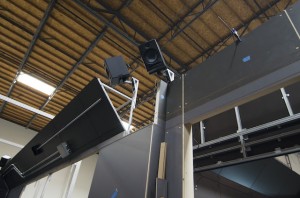PreSonus Helps Avengers S.T.A.T.I.O.N. Come Alive
 New York, NY- July 2014… After nearly half a century, more than 700 comics, and a dozen motion pictures, fan fascination with Marvel’s The Avengers franchise shows no sign of slowing down. The newest iteration, Avengers S.T.A.T.I.O.N. (Scientific Training And Tactical Intelligence Operative Network), has just opened its doors in Manhattan’s Discovery Times Square, in the home of what was once the famed New York Times building.
New York, NY- July 2014… After nearly half a century, more than 700 comics, and a dozen motion pictures, fan fascination with Marvel’s The Avengers franchise shows no sign of slowing down. The newest iteration, Avengers S.T.A.T.I.O.N. (Scientific Training And Tactical Intelligence Operative Network), has just opened its doors in Manhattan’s Discovery Times Square, in the home of what was once the famed New York Times building.
As the exhibition’s audio supervisor, Mark Edward Lewis, explains, Avengers S.T.A.T.I.O.N., produced by Victory Hill Exhibitions in association with Marvel Entertainment, is “an amazing, interactive, multimedia integration of Marvel characters that we love, with cutting-edge audio and video technology, in a giant 10,000-square-foot exhibit housed in one of the most celebrated legacy venues in America.”
Visitors to Avengers S.T.A.T.I.O.N. can enjoy a wealth of exhibits that both excite and inform – everything from exploring Captain America’s Birth Pod and the Tesseract Portal Device to soaring in a flight simulator and witnessing a particle accelerator. “It’s very science-oriented,” says Lewis. “Each of the rooms is a different kind of science that is fun, but you’re also learning about DNA and gamma radiation and bio science and all sorts of other things.”
Sound plays an important part of the exhibit’s interactive experience, with Lewis and senior sound designer Frank Serafine creating a powerful sonic environment to complement the exquisite visual experience. As Serafine explains, the challenge was not only to create an amazing sonic experience but to do so in an environment that bore all the earmarks of an acoustical nightmare.
“The biggest problem we had was isolation,” he says. “The space is basically a concrete basement with parallel walls, and we had to find a way to keep the sound from each part of the exhibit from leaking through to the rest of the space.”
Lewis and Serafine found the solution by bringing in a range of PreSonus® near-field monitors, including Eris™ E5 and E8 and Sceptre™ S6. “The PreSonus monitors – the S6 in particular – are some of the most directional speakers I’ve ever heard,” says Lewis. “They enabled us to focus the sound within a really narrow area where people would be standing, while keeping it isolated from the rest of the exhibit.”
The 5.25-inch E5 and 8-inch E8 feature Kevlar® low frequency transducers, low-mass silk-dome tweeters, responsive Class AB amplification, and professional acoustic-adjustment controls. The S6 features a unique coaxial transducer, combining DSP time-correction and point-source design for a symmetrical soundstage and micro-definition imaging.
To handle low frequencies, Lewis and Serafine chose the PreSonus Temblor™ T10 subwoofer. The T10 features a 10-inch, glass-composite, low-frequency transducer and a front-firing, bass-reflex acoustic port. “For us, the T10 was the ideal sub for delivering strong bass frequencies in this kind of enveloping room,” says Lewis. “Because the T10’s port is in the front, sound doesn’t get projected out the back and bounce off the ceiling and walls. Anywhere we had an enclosed space, the T10 was the perfect thing for us.”
The need for multiple tracks of audio playback was another area where PreSonus offered an ideal solution, with Lewis and Serafine opting for AudioBox™ 1818VSL and 22VSL multichannel interfaces.
“When you’re running 220-plus speakers and 168 discrete channels in a 10,000 square foot exhibit, you’ve got to have DSP,” Lewis observes. “What’s great about the AudioBox VSL is that it’s got more than enough DSP per channel – not just EQ, but compression, limiting, even some reverb. We’ve got discrete control of the sounds, which makes it a great alternative to using a lot of expensive DTS encoders.”
Serafine points to wireless iPad® control as one of the most important advantages in using the AudioBox 1818VSL. “Once the exhibit is set up, all of these workstations will be behind walls,” he explains. “Having the ability to mix and adjust remotely via an iPad means we don’t have to open up a wall to adjust the sound. It’s a huge advantage.”
PreSonus Studio One® DAW was more than up to the task of playing back the multiple tracks of music and effects. “Some of the soundscapes are comprised of a large number of tracks, and stability is not something we can compromise on in a setting like this,” remarks Serafine. “Studio One is one of the most rock-solid programs out there, and it sounds fantastic.”
Lewis sums it up: “As multimedia artists, audio is one of the most immersive tools we have. If it’s done well, it becomes an integral, powerful, but almost unconscious part of the experience – passive but moving at the same time. The sounds we choose, the way we mix them, and the equipment we use to convey that to the audience, are all critical to the experience. And PreSonus is a big part of that experience.”


